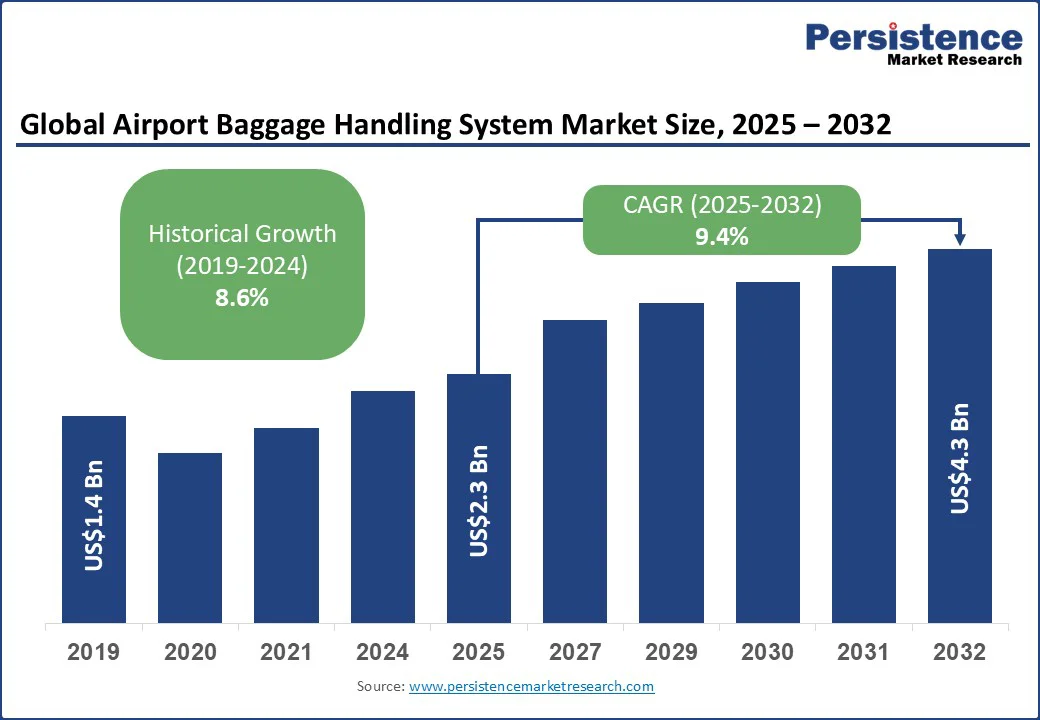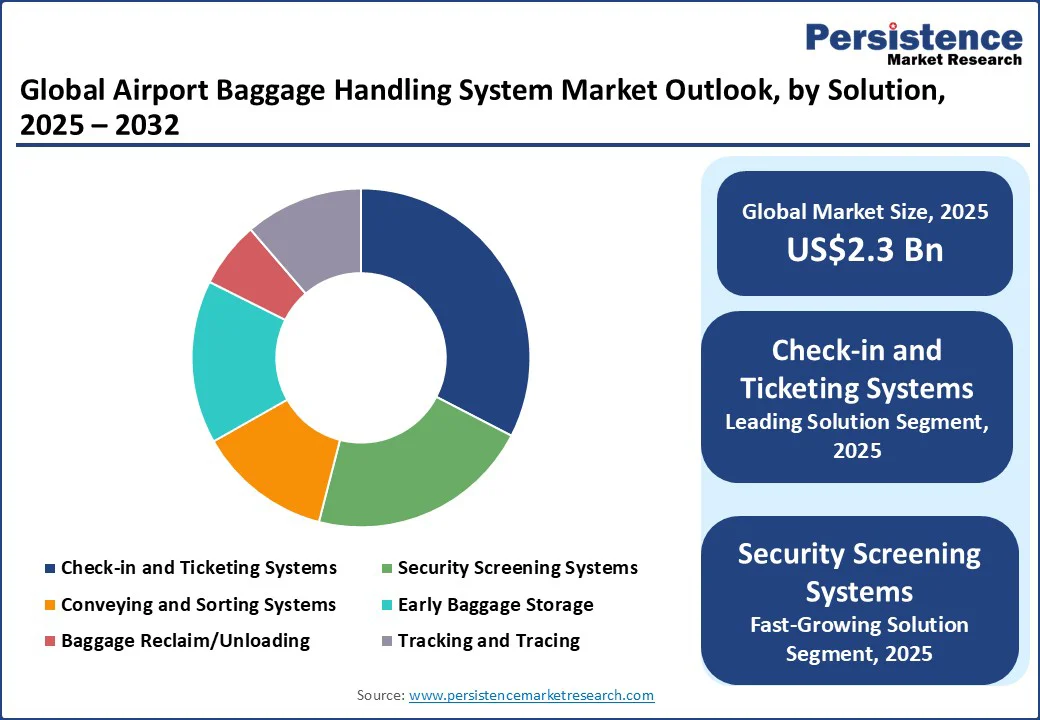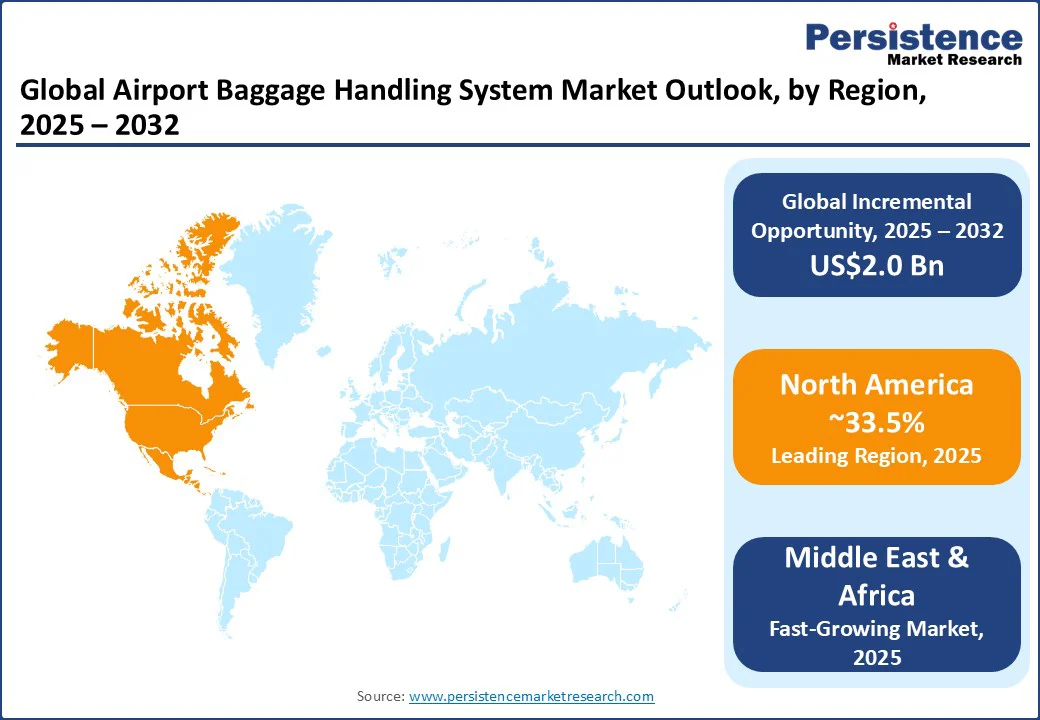ID: PMRREP35649| 178 Pages | 24 Sep 2025 | Format: PDF, Excel, PPT* | Industrial Automation

The airport baggage handling system market size is likely to be valued at US$2.3 Bn in 2025 and is estimated to reach US$4.3 Bn in 2032, growing at a CAGR of 9.4% during the forecast period 2025 - 2032, driven by the recovery in passenger traffic, ongoing capacity-building initiatives, and airports’ increasing adoption of automation to address workforce shortages and rising security compliance expenses.
Key Industry Highlights:

| Key Insights | Details |
|---|---|
| Airport Baggage Handling System Market Size (2025E) | US$2.3 Bn |
| Market Value Forecast (2032F) | US$4.3 Bn |
| Projected Growth (CAGR 2025 to 2032) | 9.4% |
| Historical Market Growth (CAGR 2019 to 2024) | 8.6% |
The rebound in international travel is directly pushing airports to upgrade baggage handling systems. With post-pandemic traffic surpassing previous peaks in different regions, delays and risks of mishandling have multiplied. Airports cannot rely on old conveyors or manual intervention to manage such loads.
For example, Heathrow Airport has invested in unique CT screening and baggage automation to reduce queuing and mishandling during summer travel surges. Similarly, India’s busy airports, including Delhi and Mumbai, are expanding baggage capacity to handle record domestic travel.
Major airport expansion projects worldwide are fueling demand for new baggage handling systems. Large hub airports are embedding state-of-the-art baggage infrastructure in terminal upgrades and new construction. For instance, Changi Airport’s Terminal 5 development includes a fully integrated, high-speed baggage handling system designed to accommodate long-term growth.
In the Middle East, Hamad International Airport in Doha recently expanded with additional baggage capacity linked to its new concourse, ensuring smoother connections for its transit-heavy passenger base. These projects not only create opportunities for system suppliers but also set new standards for integration, sustainability, and resilience.
Airports are prioritizing baggage systems that provide automation from check-in to aircraft loading, eliminating bottlenecks and minimizing labor dependency. End-to-end solutions integrate self-bag-drop counters, RFID tagging, tilt-tray sorters, and automated loading onto carts or ULDs.
At Munich Airport, a fully automated baggage transport system now connects terminals with aircraft stands using driverless vehicles. Similarly, Hong Kong International Airport has broadened its use of early baggage storage and automated sorting, ensuring 24/7 resilience with minimal human intervention.
A key restraint for baggage handling upgrades is the persistence of old IT infrastructure that struggles to integrate with the latest digital systems. Several airports still operate on legacy software that cannot easily connect with AI-based analytics or RFID-based tracking. This leads to patchwork upgrades where new components function below potential due to compatibility issues.
For example, several U.S. regional airports faced delays in introducing TSA-mandated CT scanners as existing baggage software could not synchronize data flows. Such gaps increase downtime during integration and raise the risk of system crashes. Without unified platforms, airports hesitate to commit to large-scale digital transformations, slowing down the adoption of new baggage handling solutions.
Baggage handling systems demand substantial upfront capital, and the return on these investments often takes years to materialize, making airports cautious. Large hub expansions such as Beijing Daxing or Dubai International justify the cost, but mid-sized airports struggle to balance budgets when passenger growth is less predictable.
A recent example is Kansas City International Airport’s new terminal, where baggage automation required significant funding approval, sparking debate over long-term payback against projected traffic. Additionally, ongoing maintenance, software upgrades, and compliance costs add to lifecycle expenses.
The pandemic has created opportunities for baggage handling providers to deliver disinfection features as retrofits rather than full system overhauls. Airports are integrating UV-C modules and antimicrobial conveyor surfaces to assure passengers of safe travel environments. Hong Kong International Airport piloted UV-C disinfection for baggage trolleys and luggage conveyors, setting a precedent for other hubs.
These add-ons are less capital-intensive than full replacements and can be marketed as visible health-safety measures, which airlines and airports now use to strengthen traveler confidence. As public health remains a concern, vendors providing modular disinfection upgrades are finding a niche growth area.
Early baggage storage systems are evolving from operational tools into new revenue streams. By allowing passengers to check in luggage hours before departure, airports can ease peak-time pressure and simultaneously monetize storage through premium services.
Doha’s Hamad International has developed EBS modules that not only optimize sorting but also support ancillary services such as early check-in for luxury passengers and tour groups. Similarly, Amsterdam Schiphol delivers off-site check-in and storage linked to its baggage system, which improves passenger convenience while enabling new business models.
With IATA’s Resolution 753 mandating end-to-end baggage tracking, RFID adoption is becoming a key opportunity. RFID enables continuous, real-time tracking without manual scanning, which appeals to both airports and passengers. Delta Airlines has rolled out RFID-enabled tags across its U.S. network, letting travelers track their bags on mobile apps.
Airports in Asia Pacific, such as Hong Kong International, have also integrated RFID tags directly into baggage systems, complying with global standards and refining operational transparency. Vendors providing RFID-compatible conveyors, scanners, and data platforms stand to benefit as more airports shift toward integrated baggage management models.
Based on the solution, check-in and ticketing systems account for nearly 32.6% of the market share in 2025. These elements directly impact passenger experience and operational efficiency at airports. Automated self-check-in kiosks and mobile boarding solutions cut queues and reduce staff dependence, which is important in busy hubs.
Security screening systems are anticipated to witness a steady demand as airports face strict global compliance requirements and cannot afford lapses. Governments and aviation regulators frequently update screening standards, which pushes airports to upgrade existing systems.
In terms of technology, barcodes hold approximately 36.2% of the global market share in 2025. This is attributed to their cost-effectiveness, easy implementation, and universal compatibility across airlines and airports. Almost every passenger today carries a smartphone that can scan or generate barcodes, making adoption smooth.
RFID anchors are gaining impetus as they provide real-time tracking and reduce mishandling rates compared to barcodes. The technology allows continuous monitoring of baggage location without requiring a direct line of sight, which barcodes need. Delta Airlines has already deployed RFID at more than 80 airports in the U.S., allowing passengers to track their bags through the Fly Delta app with live updates.
By system type, conveyor-belt systems control around 44.8% of the market share in 2025, due to their ability to form the backbone of baggage handling, especially in large and high-traffic airports. They are valued for their ability to move bags continuously over long distances, connecting check-in, security, and loading zones without manual intervention.
Tilt-tray and cross-belt sorters are witnessing considerable growth as they provide high accuracy and speed in baggage distribution. These systems are capable of sorting bags to multiple destinations simultaneously, reducing congestion and transfer delays.

In 2025, North America is predicted to account for approximately 33.5% of the market share. Airports in the region are prioritizing upgrades of baggage handling systems to address aging infrastructure and passenger surges.
Several U.S. airports built in the 1980s to 1990s are undergoing modernization, and baggage systems are being overhauled as part of these projects. For instance, Denver International Airport’s Great Hall Project includes unique baggage automation to improve flow and reduce mishandling.
A defining trend is the emphasis on integrating in-line baggage screening with TSA standards. U.S. airports continue to replace aging standalone explosive-detection units with fully-integrated in-line systems, cutting down manual checks and speeding up operations. Seattle-Tacoma International Airport recently completed such an upgrade, centralizing screening while improving security compliance.
The Middle East & Africa is speculated to exhibit a CAGR of around 12.4% from 2025 to 2032, becoming the fastest-growing region. Baggage handling systems are closely linked to the region’s push for large-scale airport expansions and hub positioning. Dubai International Airport and Hamad International Airport in Doha have both deployed high-capacity and fully automated systems capable of handling tens of thousands of bags per hour.
Airports in Saudi Arabia are also upgrading their systems to comply with Vision 2030, which emphasizes smart infrastructure. The new King Abdulaziz International Airport in Jeddah has introduced integrated baggage handling with RFID tagging to cut mishandling rates and refine real-time tracking for both operators and passengers.
In Africa, modernization is more selective and tied to international partnerships. Addis Ababa Bole International Airport, a key hub for Ethiopian Airlines, has invested in novel baggage sorting and conveyor expansions as part of its terminal upgrade.
In Asia Pacific, baggage handling system upgrades are associated with the ongoing expansion of mega-airports and the return of high-volume international travel. China has been opening new large-scale airports such as Beijing Daxing, which features a unique early baggage storage system and high-speed conveyors designed to manage complex passenger flows.
India is focusing on modernization to cope with rising domestic traffic. Delhi’s Indira Gandhi International Airport recently upgraded its baggage handling system with a tilt-tray sorter and RFID integration to reduce delays and improve tracking accuracy. Bangalore Airport has also adopted self-bag-drop units connected directly to an automated conveyor system, complying with its vision of becoming a fully digital airport.

The global airport baggage handling system market is consolidated with the presence of large global integrators. Market leaders such as Vanderlande, Daifuku, BEUMER, Fives, and Siemens/Siemens Logistics control the majority of air-side installs and full-lifecycle service contracts. Differentiation now centers on software and services, not just conveyors. Vendors that blend proven mechanical reliability with digital twins, predictive-maintenance suites, and real-time analytics win high-margin contracts.
Leading airport baggage handling system vendors focus on digital innovation, embedding AI, digital twins, and predictive maintenance to secure long-term contracts. Cost leadership emerges through modular retrofits and energy-efficient designs. Market expansion is driven by acquisitions and regional partnerships. Service-based models, subscription analytics, and cybersecurity assurance are becoming dominant differentiators.
The airport baggage handling system market is projected to reach US$2.3 Bn in 2025.
Surge in passenger traffic and rising security mandates are the key market drivers.
The airport baggage handling system market is poised to witness a CAGR of 9.4% from 2025 to 2032.
Key opportunities include widespread rollout of RFID and early baggage storage systems.
Daifuku Co., Ltd., Siemens AG, and Vanderlande Industries BV are a few key market players.
| Report Attribute | Details |
|---|---|
| Historical Data/Actuals | 2019 - 2024 |
| Forecast Period | 2025 - 2032 |
| Market Analysis | Value: US$ Bn |
| Geographical Coverage |
|
| Segmental Coverage |
|
| Competitive Analysis |
|
| Report Highlights |
|
By Airport Capacity
By Solution
By Technology
By System Type
By Region
Delivery Timelines
For more information on this report and its delivery timelines please get in touch with our sales team.
About Author